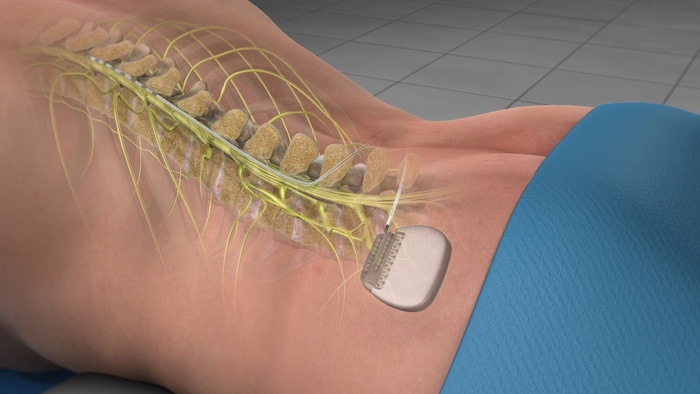
An Innovative Alternative for Unrelieved Chronic Pain
Spinal cord stimulation (SCS) is an innovative technology that addresses some of the most difficult pain problems experienced. Identified as an effective treatment option for many chronic sufferers, SCS is most often used for neuropathic pain, including diabetic neuropathy, post-laminectomy syndrome (residual pain after back surgery), and complex regional pain syndrome (CRPS). If you suffer from chronic neuropathic pain, spinal cord stimulation (SCS) may enable you to control and relieve your pain. The board-certified pain specialists can determine if this is an option for you and help stop pain from interfering with your life.
How Does SCS Help?
Neuropathic pain occurs when there is an injury, disease, or trauma to the central nervous system (spinal cord) or peripheral nervous system (any nerves outside the spinal column). Neuropathic pain symptoms can cause you to experience sharp, pricking, and/or stabbing pain in the lower or upper extremities. You may experience a high degree of pain from something as simple as a light touch or a brush against the skin. You may also feel an increased response to a painful stimulus. A pinprick, for example, would cause intense pain beyond what would normally be experienced. Spinal cord stimulation provides pain relief by using an implanted device that transmits mild electrical impulses to the spinal cord. The stimulation interrupts the feeling of pain, substituting a more pleasing sensation called paresthesia. This feeling can differ from patient to patient but is often described as a pleasant tingling.
How Does SCS Work?
It begins with an in-office trial to confirm a successful response. When SCS is introduced on a trial basis, a temporary stimulator is implanted to determine if the therapy provides satisfactory pain relief. It’s an important step to find out if you are comfortable with the sensations of spinal stimulation. The stimulation trial requires relatively little time and is performed on an outpatient basis in a sterile office setting. A local anesthetic is used to numb the area before one or more leads are placed in the epidural space along the spinal cord. These soft, thin wires with electrical leads on their tips are placed using a thin needle. After the leads are securely positioned, they are connected to a small, portable, external generator programmed to send mild electrical pulses that replace your areas of intense pain with paresthesia. Your doctor will determine the length of the trial period. It may last for a few days up to one week at most. The trial tests how well you respond to stimulation throughout the day. At home, you can determine how well the stimulation helps control your pain during your daily routine and how it impacts your ability to engage in different activities. You should take notes to keep track of how the stimulation covers your pain, so you can share this information with your doctor, who will be closely monitoring your progress. If your trial is successful, and you and your doctor decide you will benefit from SCS, your doctor will work with you to schedule the placement of a permanent SCS system. It’s important to know that SCS allows you to be in control. Using a magnetic remote control, you can turn the current on and off, or adjust the intensity, rapidly responding to changes in the location or severity of your pain. Since the system is portable, SCS makes it possible to resume many normal daily life activities at home and at work, as well as recreational activities, such as swimming, traveling, biking, and gardening. SCS also enables many people to reduce or eliminate the use of pain medications. Keep in mind that even though an SCS system is called permanent, it is a reversible therapy. If treatment should no longer be needed, the implanted parts can be easily removed.
How Long Does It Take?
The trial implantation takes approximately 30 to 45 minutes and is followed by a short period of observed recovery. The procedure to implant the long-term device is performed by a surgeon in an outpatient surgical setting and generally takes about two hours.
What Are the Expected Results?
SCS can be an effective way to decrease the severity of chronic pain to a more manageable level. There are many clinical studies supporting the effectiveness of SCS therapy. While the degree of pain relief varies from person to person, these studies show that 85 to 90 percent of those who have undergone treatment report a 50 to 70 percent reduction in overall pain. Many also report a significant increase in their ability to enjoy normal family and work activities again.
Precision Pain Care and Rehabilitation has two convenient locations in Richmond Hill – Queens and New Hyde Park – Long Island. Call the Richmond Hill office at (718) 215-1888, or (516) 419-4480 for the Long Island office, to arrange an appointment with our Interventional Pain Management Specialist, Dr. Jeffrey Chacko.













